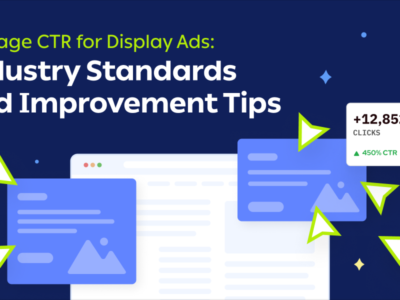I think we can all agree that our mobile screens have become the primary gateway to information, entertainment, and communication. With that, it has also led to exposing us to advertisement overload.
And because of this, consumers tend to see a lot of irrelevant ads.
To avoid this and make sure that potential customers are served ads that don’t negatively impact their mobile screen time, mobile ad targeting is the key.
A. What Is Mobile Ad Targeting?
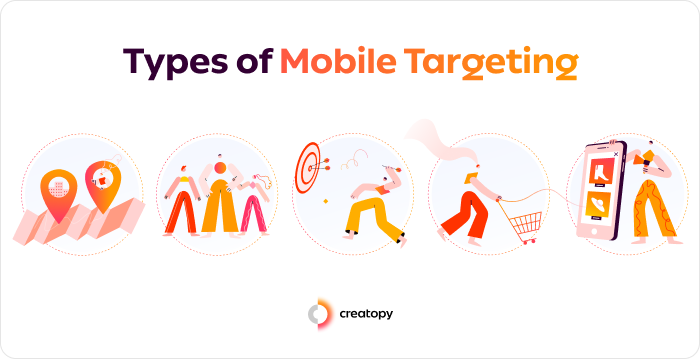
Mobile targeting is the process that allows advertisers to reach potential customers on their smartphones and serve them customized ads, based on demographic data, browsing behavior, location, or interests.
Thanks to targeted mobile advertising, businesses can show their ads to people who would be most interested in their products/services, thus using their online advertising budget in the smartest way possible.
The users also benefit from mobile ad targeting, as they enjoy a better experience while browsing on their phones.
Targeting audiences on mobile takes the guesswork out of the equation and allows advertisers to create laser-focused ad campaigns.
B. What Are The Types of Mobile Targeting?
1. Demographic targeting
In order for your mobile ads campaign to be effective, it needs to address the right audience.
Before even designing your ads, crafting your message, or setting up your campaign, start by putting together the profile of your ideal target audience.
Another thing you can do is conduct a market research to identify your audience’s demographic data. Don’t just assume your target’s demographics—research them. And only after you have clearly defined your target’s demographic data can you create your ads and set up a targeted mobile ads campaign.
Here are the most common demographic data that most ad networks will allow you to target:
- Location. The whereabouts of the people you want to target define their behavior, interests, and even income.
- Age range. It can influence people’s interests, hobbies, and browsing behavior.
- Gender. It’s essential if you sell gender-specific products, like feminine hygiene products or sports equipment for men.
- Language. This should be in your mind when you set up targeted ads to reach consumers that live in a different country.
- Education. It can influence people’s interests and even determine what language you can use to communicate.
- Devices. You can target people by the device they use. Ideally, you will target both iOS and Android users.
- Familial status. Some networks allow you to target people by familial status, which is great because some milestone purchases, like buying a house or a car, usually happen when people start a family.
- Occupation. This tells a lot about income, interests, and hobbies.
Once you have identified your target audience, you can use this data to create lookalike audiences. These are potential customers who share similar traits with your main audience.
2. Location-based targeting
Geo-targeting is a practice that delivers custom ads to online users based on their geographic location. This type of targeting is extremely useful for local businesses like restaurants, shops, delivery services, cleaning agencies, and more.
By targeting people who live in a specific area, advertisers can make use of their marketing budgets more efficiently.
Google Ads, Facebook, Twitter, Instagram, and LinkedIn are some of the most well-known platforms and social networks that provide geo-location targeting.
For example, with Google Ads, you can target users located in specific countries, regions, or within a certain radius. Also, you can target ads based on location groups, which means business locations, tiered demographics, or places of interest.
But there’s a catch with geo-targeting. In order for geo-targeted mobile ads to be efficient, advertisers need to couple targeting a specific area with the right content for that location. This means that your ads must be location-specific, and need to use specific elements like language, currency, or even cultural references.
Programmatic advertising can take geo-targeting even a step further. Demand-side platforms can track users’ location, enabling them to use real-time information about the geographic location of potential customers. When geo-targeting is combined with other user data, such as demographics and behavior, advertisers can reach users who may be the most interested in your ad.
Radius targeting (also known as proximity targeting) is a more specific form of geo-targeting, and it increases the chances of reaching the right audience. This type of geo-targeting allows you to show your ads to users within a certain distance from your business.
For example, an Italian restaurant in New York can use ads to target people living/working/or visiting the area and invite them in for lunch or dinner. Radius targeting is the best method local businesses can use to avoid wasting money on ads that are shown to people living on the other side of New York, who may never cross town for lunch.
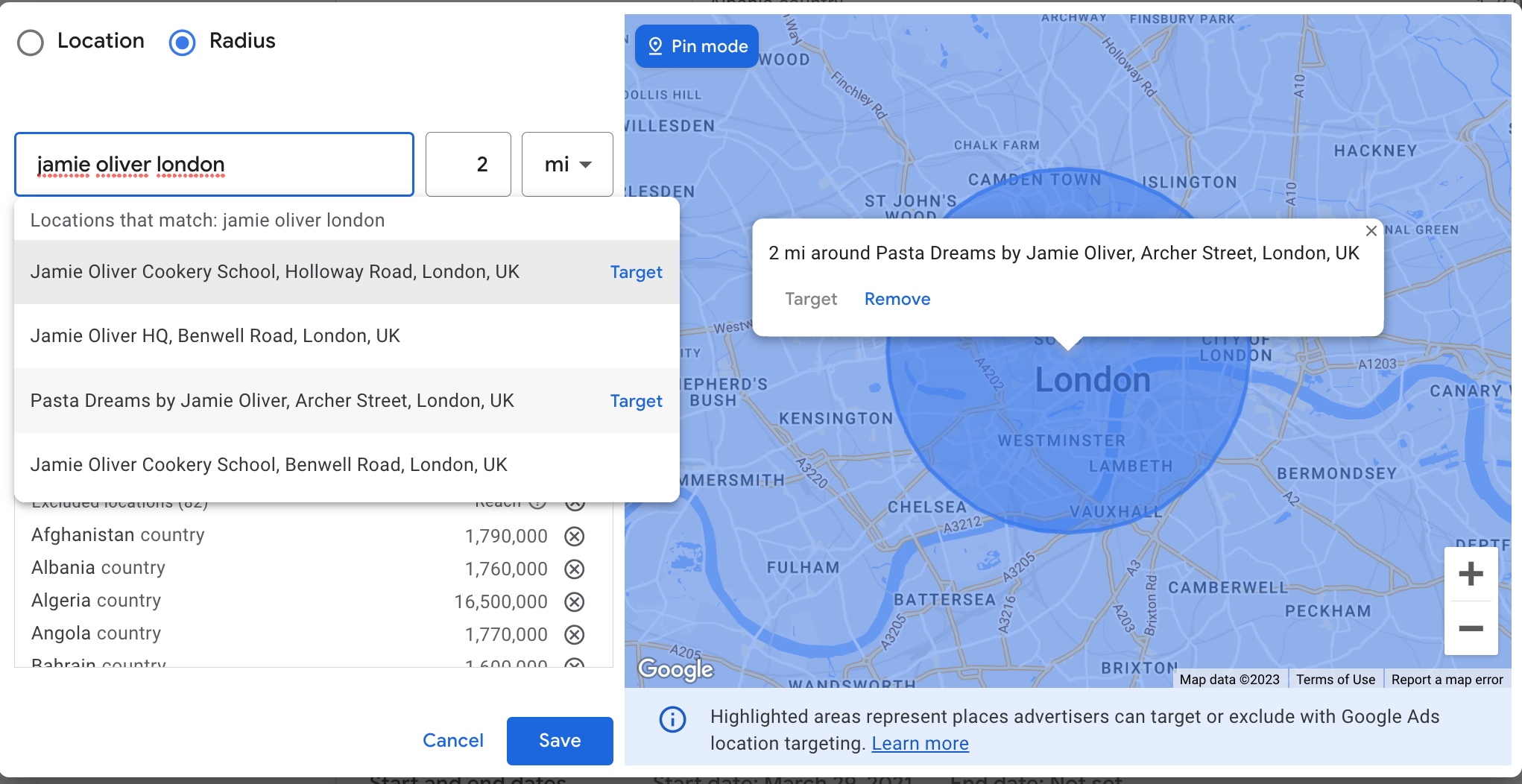 However, if you decide to use radius targeting for your mobile banner ads campaigns, make sure to select a broad area that is big enough so that your ads will actually be shown to someone. Google warns us that by targeting “a small radius or very small location, your ads might only show intermittently or not at all.” And that’s because small areas may not meet the platform’s criteria.
However, if you decide to use radius targeting for your mobile banner ads campaigns, make sure to select a broad area that is big enough so that your ads will actually be shown to someone. Google warns us that by targeting “a small radius or very small location, your ads might only show intermittently or not at all.” And that’s because small areas may not meet the platform’s criteria.
Geo-fencing is a mobile device targeting method that uses a specific area around a location to show relevant ads to any user entering the radius. Ads can be anything from SMS messages to in-app notifications, emails, or social media ads.
Geo-fencing is especially suited for local businesses that want to reach potential customers when they’re in proximity. It is also an excellent tactic for big brands running promotions at brick-and-mortar locations.
To understand how this works, imagine you’re walking into a mall, and a notification pops up on your phone. You see that it’s an ad from your favorite clothing brand app, and they’re giving you a 30% discount on any clothing item.
Burger King’s “Whopper Detour” is probably one of the most known geo-fencing campaigns for mobile. They targeted customers’ smartphones as they were approaching their biggest competitor’s (McDonald’s) location. Smartphone users who were within 600 feet of McDonald’s were able to redeem and offer and get a Burger King Whopper sandwich for just a penny.
After customers placed the order, the app then directed them away from McDonald’s and towards the nearest Burger King to pick up their sandwich.
The goal of this campaign was to promote Burger King’s order-ahead feature in their new mobile app. And the truth is they managed to create quite a lot of buzz.
3. Behavioral targeting
Using data management platforms (DMPs), marketers can collect and store mobile users’ data such as web searches, purchase history, navigation history, communications, social media clicks and check-ins, and other information to create user profiles. Based on these profiles, advertisers can create more personalized and relevant ads that increase user engagement, a higher click-through rate, conversion rate, and sales.
For example, a user searched for a vacuum cleaner on Google. After a few hours, this person grabs their phone and browses a news website, and sees an ad for a vacuum cleaner from a brand. The next day, while scrolling on Facebook, the same user is served an ad promoting a huge discount for home appliances from another online store. This is behavioral targeting in a nutshell.
4. Contextual targeting
This mobile audience targeting method refers to placing ads on pages with related content. One example of contextual targeting is when you visit a travel website, and you’re shown ads of foreign countries, airlines, or hotels you can book.
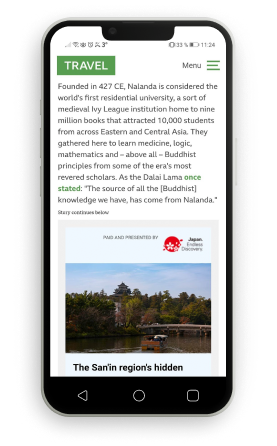
Unlike behavioral targeting, contextual targeting uses real-time information from the current session and not collected and stored data.
Since the internet is moving towards a data privacy era, with Google’s transition to a cookieless future, and Apple’s ATT framework, contextual targeting may soon replace behavioral targeting, as it will no longer be possible to collect user data. Worldwide privacy and data regulations such as the GDPR in the EU and CCPA in the US are making sure we, as a society, are heading towards a world of personal data safety.
5. Interest-based targeting
Interests targeting allows you to show ads to people who have shown an interest in your product/service category or topic.
Moreover, Google Ads created the custom audience segments, which means that you can use keywords for narrow targeting.
For example, if you’re selling sports outwear gear, you can use keywords such as “waterproof outwear”, “lightweight sports jacket”, or “core fitness.”
You can even add specific URLs, or apps.
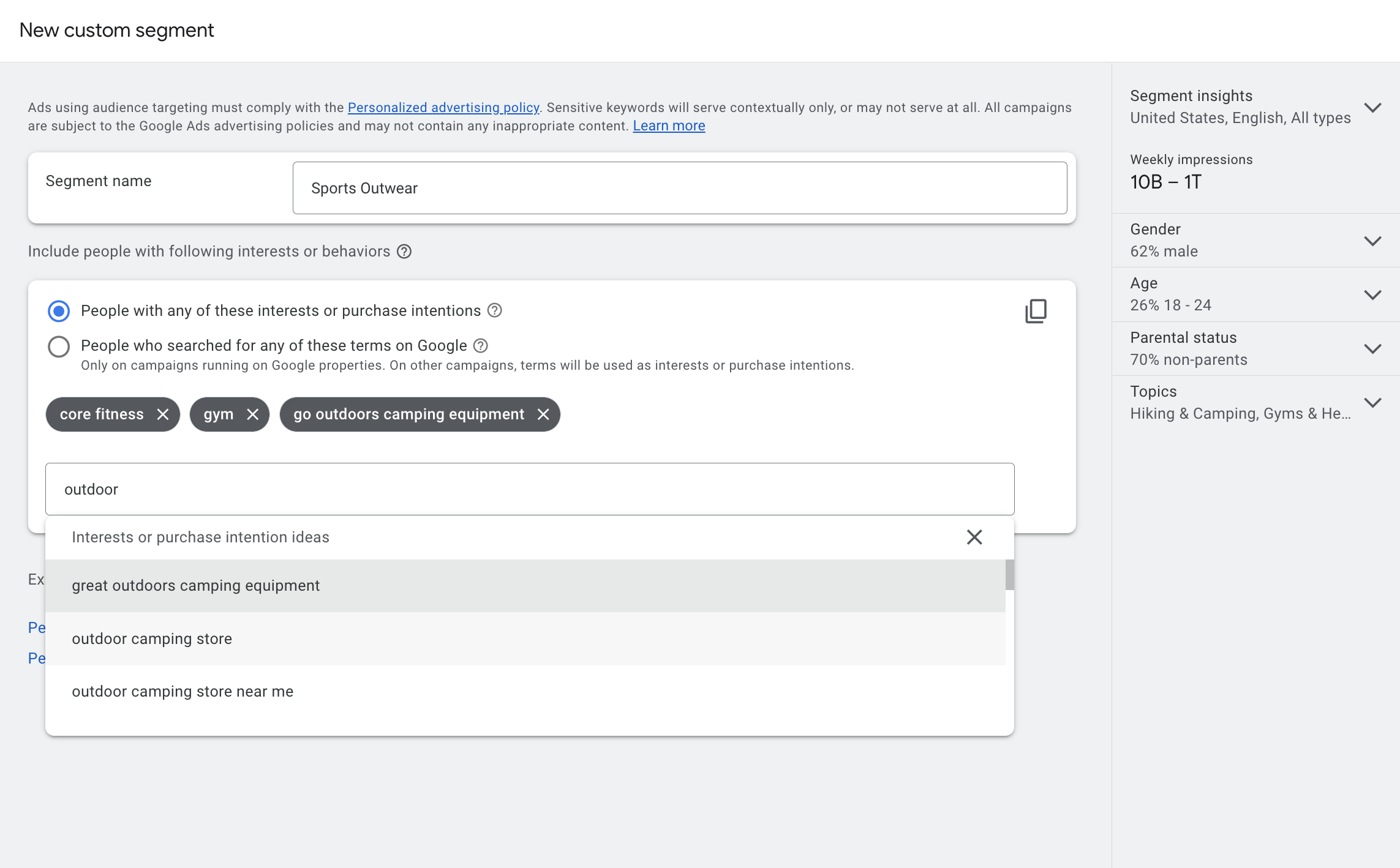
To create custom audiences using keywords, phrases, website URLs, or apps, in your Google account, go to Tools and settings, select Shared Libraries > Audience manager > Custom segments, then click on the + sign to create a new custom audience.
6. App targeting
Advertising on mobile websites and on apps share many similarities. However, some key differences make in-app targeting more effective.
For example, a user is identified within an app by his device ID. This enables enhanced targeting and customization of ads. Furthermore, people use apps on an opt-in basis, and their device ID lasts for an average of 21 months, while mobile websites cookies only last for 24 hours.
In-app tracking can provide user data such as their GPS location, device type, operating system, gender, age, and wireless carrier.
Another advantage of in-app advertising is that ad blockers do not block ads.
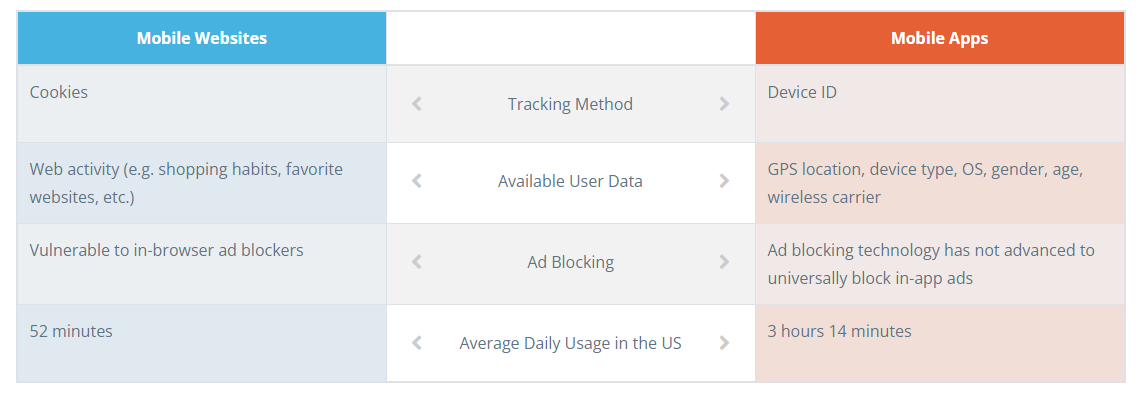
According to Smaato, people spend more time in apps than browsing the web (3 hours and 15 minutes versus 52 minutes) on their mobile phones. Not only do people spend more time in apps, but it seems like they perceive their favorite apps as their personal space. For advertisers, this means that they can create effective advertising touchpoints.
In-app ad targeting is more accurate because apps can collect first-party data on opt-in. That’s where apps can collect valuable user information such as gender, or age.
Most ad networks will offer a mix of some of these audience targeting options:
- Demographics (age, gender, location, education, marital status, parental status)
- Interests
- Device type (iOS or Android)
- Values
- Behavior
- Habits
Apple Search Ads has more targeting options for iOS users, but it also depends on your budget, as they offer two versions of ads: Apple Search Ads Basic and Apple Search Ads Advanced. If you’re willing to invest more than $10.000 for in-app ads, here’s what you can get with Apple Search Ads Advanced:
- Search Match. This automatically matches the ad to the relevant searches;
- Keywords. You can either choose your own keywords or pick some from Apple’s suggestions;
- Customer types. You can show your ads to new customers, existing customers, returning customers, users of other apps, or to everyone;
- Demographics;
- Device type. iPhone or iPad;
- Locations.
Here are some of the networks that can help you with in-app advertising: AdsCompass, Smaato, RevX, PropellerAds, HilltopAds, AdsterraNetwork, AdMaven, AppSamurai, and Apple Search Ads.
Other targeting types:
- Device targeting
- Operating system targeting
- Provider targeting (this refers to the network operator)
C. The Importance of Mobile Ad Targeting
Both advertisers and users benefit from ad targeting when it’s done right.
These are the main benefits of mobile ad targeting:
- Better targeting and personalization of ads – Optimized mobile ad targeting allows brands to reach people who would be the most interested in their ads and products.
- A better ad experience for the consumers – Online users receive an improved customer experience through personalized ads. Instead of being disturbed and distracted by irrelevant ads, users receive relevant ads that could be of interest to them.
- Increased engagement and conversion rates – Mobile ad targeting increases the chances of ad clicking, conversion rates, and, ultimately, sales.
- Better ROAS – Ultimately, marketers are interested in what they gain from an advertising campaign. Targeting helps companies get better results, and increase ROAS.
- Minimal waste of budgets – With personalized ads, the risks are minimal. By showing relevant ads to selected groups of mobile users, companies avoid spending their budgets on large audiences.
D. What Are the Best Practices for Mobile Ad Targeting?
1. Segmentation and targeting the right audience
Targeting the right audience is a complex process and must be done meticulously. One of the first steps you should take is splitting your audience into segments, using segmentation criteria like demographics, behavioral patterns, and behavioral habits.
Most ad networks allow audience segmentation and targeting, which increases the chances of reaching the right people interested in your business.
Here’s what segmentation looks like in Google Ads:
- Affinity segments. Reach users based on their habits, and interests;
- Custom segments. Reach people by keywords, URLs, and apps;
- Detailed demographics. Reach people based on their parental status, marital status, education, and homeownership status;
- Data segments. Reach users that have previously interacted with your business, visited your website or saw one of your videos on YouTube;
- Customer match. Reach your existing customers and other contacts whose data is stored in your CRM;
- In-market audiences. Reach people based on what they are actively researching or planning;
- Combined segments. Combine different audience segments in just one audience.
2. Use the data to drive targeting decisions
Once you work with AI-powered networks that help you collect so much information about users, you can use it to further act on targeting the mobile ads to the right people.
Knowing your audience allows you to choose your ad placements, whether you want to go for online websites or apps. It will also be much easier to build your campaign and design your ads with your target audience in mind.
3. Relevance and personalization of the ad content
Understanding your audience can help you to create more customized and relevant ads.
Use the audience data available to choose the publishers where you can reach potential customers. Audience insights from demographic data can help you to choose ad formats better. For example, the young generation responds better to video ads and rich media interactive ads for mobile. Using rewarded video ads in game apps could help you achieve a higher conversion rate than static banner ads.
Any information about users’ education or occupation can help you decide which tone of voice to use and the exact wording.
And when people are shown relevant ads that interest them, they may even click the ad, go to your website and add the product to their shopping cart.
Bottom line: mobile targeting helps advertisers create personalized and relevant ads that increase click-through rates (CTRs) and conversion rates (CRs).
4. A/B testing and continuous optimization
No matter how well you set your campaign, the truth is, there’s no way anyone can predict how the ads are going to perform. No one can anticipate how the audience will react to certain ads.
That’s why, when launching a mobile display advertising campaign, you can start with an A/B test, and see which one performs best to try to understand what clicks with your audience.
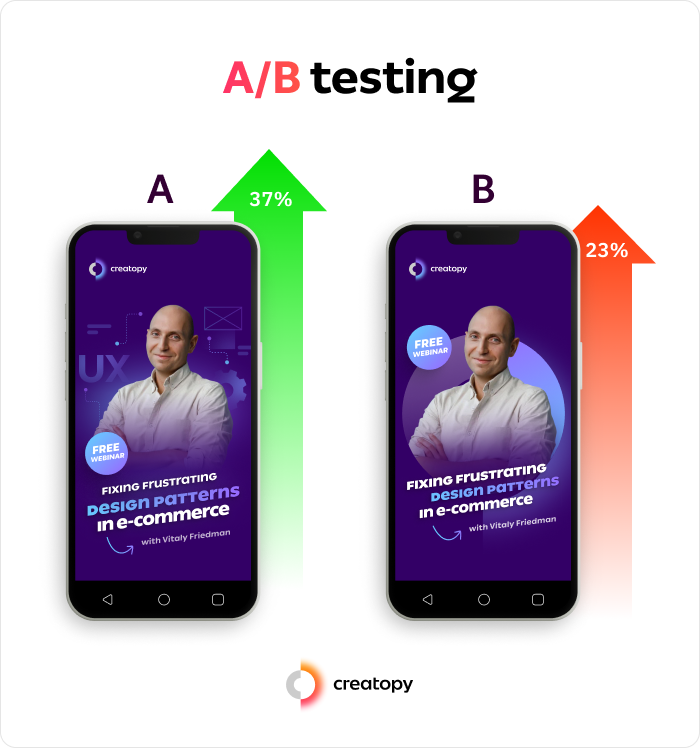
For marketers, this means that they should put aside a specific budget for A/B testing and experimenting.
To ensure your A/B testing is successful, here’s what we recommend:
- Change only one ad element at a time and test it to see how the ad performs. For example, change the background and test the ad. Then, use a different call to action and test the ad to see how it performs. If you make multiple changes at a time, you won’t know for sure which ad elements influenced the user and determined them to take action.
- Keep testing as an ongoing practice, extract the key lessons, and apply the insights you gained to optimize your ads.
For more information on how to build a powerful mobile campaign, read our complete guide to mobile advertising.
E. Challenges in Mobile Ad Targeting
Although mobile targeting provides incredible benefits for both advertisers as well as for consumers, there are some challenges:
The different operating systems (iOS and Android)
The mobile market is split between iOS and Android users, which forces advertisers to use specific ad networks and tools (depending on their marketing objectives) to reach users on both operating systems.
There are ad networks that can help advertisers run mobile ads campaigns on both Android and iOS devices, and there’s Apple Search Ads for iOS devices.
For example, if you want to run a display ads mobile campaign for Android and iOS devices, there are several mobile ad networks that can help you achieve that. But if your goal is to get users to install your app on iOS devices, the only network that you can use for that is Apple Search Ads.
Limited tracking methods
Cookies can only be set on mobile websites and not in apps. In-app tracking is done via a device ID (IDFA for Apple and Advertising ID for Google). Therefore, tracking users from websites to apps, or from one app to another app is not possible right now. Hopefully, in the future, optimization of tracking on mobile devices will allow more relevance and performance.
Ad blockers
Many people now use ad-blocking software to avoid seeing ads on their mobile devices. This makes it difficult for advertisers to reach their intended audience, particularly if they are targeting tech-savvy users.
Ad-clicking by mistake can confuse marketers
Smaller screens increase the chances of ads being clicked by mistake. We often do this, click an ad by mistake, then we’re taken to the advertiser’s website but instantly click back to the previous page where we navigated from.
Unfortunately, this ad-clicking by mistake provides metrics that do not reflect the users’ intent. It confuses marketers and can sometimes lead to wrong decisions, not to mention a waste of money.
So, because mobile devices have limited screen space, advertisers must be concise and precise in their messaging. You must carefully choose the placements of your ads to ensure they don’t interfere with the user’s experience.
Final Thoughts
It’s clear now that targeted mobile advertising is impossible without audience targeting. Employing the technology available today, we can now reach mobile users who might be interested in our ads and increase our chances of converting a potential customer into a buyer.
So, whether you choose to target your audience using their location, demographic data, interests, or purchasing history, or all of these at once, you increase your chances of conversions.







